clutch OPEL GT 2012 Owners Manual
[x] Cancel search | Manufacturer: OPEL, Model Year: 2012, Model line: GT, Model: OPEL GT 2012Pages: 190, PDF Size: 2.46 MB
Page 17 of 190
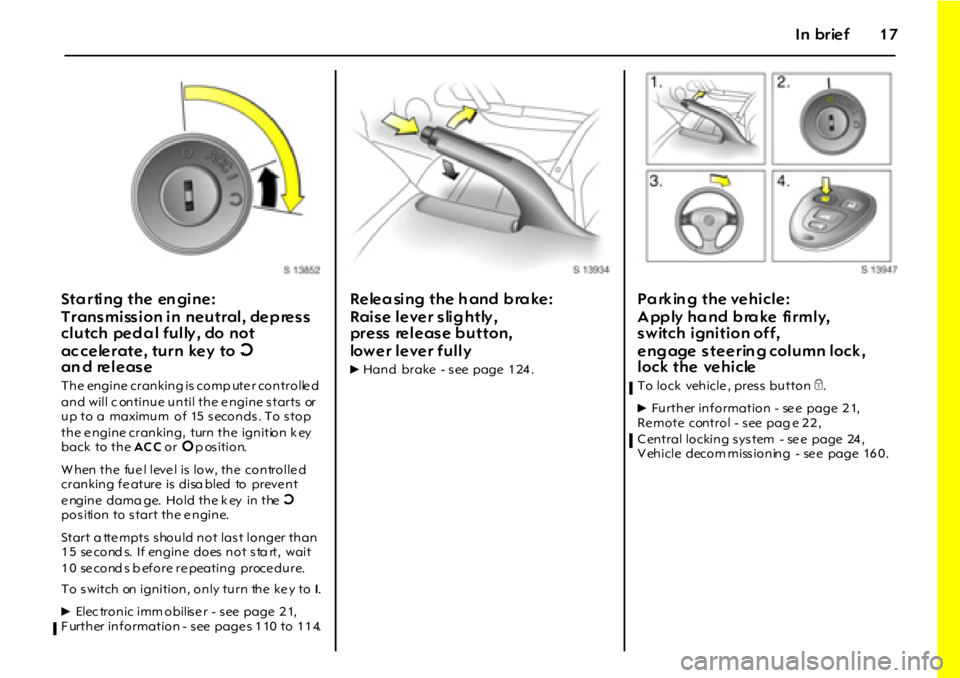
In brief17
Sta rting the en gine:
Transmission in neutral, depress
clutch ped a l fully , do not
ac celerate, turn key toY
an d release
The engine cranking is comp ute r controlle d
and will c ontinue until the engine starts or
up to a maximum of 15 s econds . To s top
the e ngine cranking, turn the ignition k ey
back to the AC C or J
JJ J position.
W hen the fue l leve l is low, the controlle d
cranking fe ature is disa bled to preve nt
e ngine dama ge. Hold the k ey in the Y
position to start the e ngine.
Start a tte mpts should not last longer than
1 5 se c o nd s. If en g i n e d o es n o t s ta rt , w a i t
1 0 se cond s b efore re peating proce dure.
To switch on ignition, only turn the ke y to I.
6Elec tronic imm obilis e r - s ee page 2 1,
F urther information - s ee page s 1 10 to 1 1 4.
Releasing the hand brake:
Raise lever slightly,
press release button,
lower lever fully
6Hand brake - s ee page 1 24 .
Pa rkin g the vehicle:
Apply hand brake firmly,
switch ignition off,
engage steerin g column lock,
lock the vehicle
To lock vehicle , pres s button e.
6Further information - se e page 2 1,
Re mote control - s ee pag e 2 2 ,
C entral locking s ys tem - se e page 24 ,
V ehicle decom miss ioning - se e page 16 0 .
Page 56 of 190

56 In struments, controls
OTurn signals
Control indicator flashes in g reen.
The rele vant control indicator fla shes when
the turn signal is on. Both control ind ic ators
flash with the hazard w arning la mps on.
Rapid fla shing: F ailure of a turn s ignal
lamp or ass ociated fus e .
Turn signals - s ee pag e s 14 , 74 ,
Change bulbs – s ee pag e 1 4 6,
F us es – se e page 14 1 .
PHe adla mp hig h be am
Control indicator illum inate s in blue.
Illuminates whe n high b eam is on a nd
during headla mp flas h – s ee page s 13 , 74 .
ZExhaust em issions
Control indica tor illuminates or flas hes in
yellow.
Illum inate s whe n the ignition is s witched on
and goes out s hortly afte r the engine has
st a r t e d .
If it illum ina te s when the engine is running:
Fault in e miss ion control s ys tem .
The pe rmitted e mis sion limits may
be e xce ed ed. Co n su l t a w o rk sh o p .
If it flashes when the engine is running:
Fault that can le ad to d estruction of the
catalytic conve rter – se e page 11 6 .
Consult a work shop imm ediately.
RBrake system, cl ut ch system
C ontrol indicator illuminates or flashe s in
re d.
Illuminates when the ig nition is switche d on
i f t h e h a n d b ra ke i s a p p li e d o r i f t h e b ra ke/
clutch fluid lev el is too low.
Flashes at sp eeds ov er 8 km /h (5 mph) if
hand brak e is app lie d.
Release ha nd brake before continuing
journe y, to avoid ove rheating and
dam aging the b rake sy ste m.
F urthe r information - s ee pag es 6 8, 12 4 ,
156.
9 Wa r nin g
If it illuminates when the hand brake is
not a pplied: Stop the ve hicle ; interrupt
your journey immediately . C onsult a
workshop.
Page 57 of 190
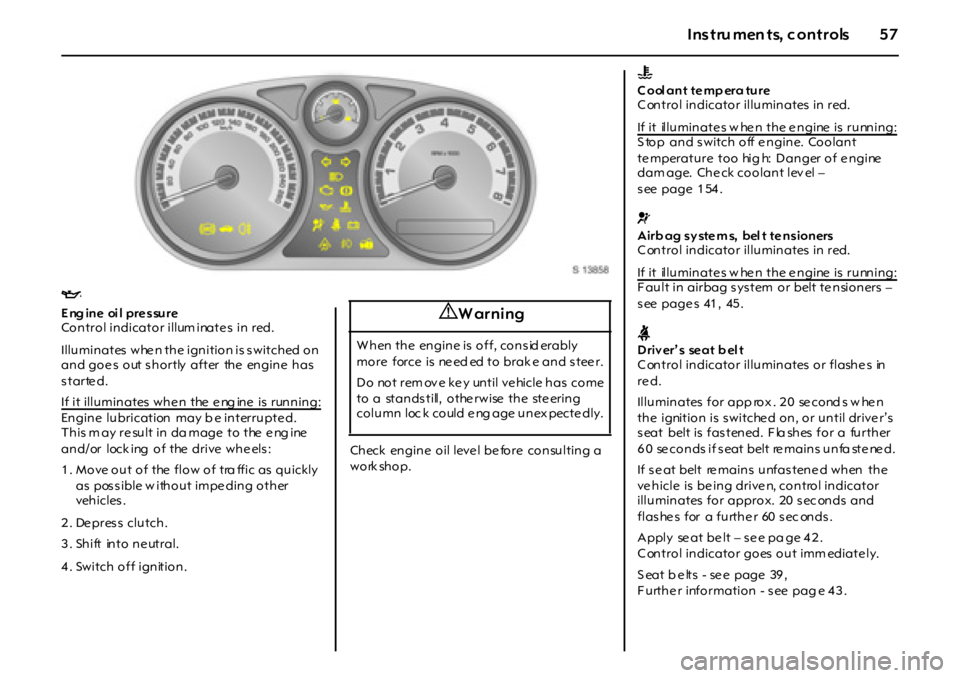
57Instru men ts, c ontrols
IEngine oil pressure
Control indicator illum inate s in red.
Illuminates whe n the ignition is switched on
and goe s out s hortly after the engine has
started.
If it illuminates whe n the e ng ine is running:
Engine lubrication may b e interrupte d.
This m ay re sult in da mage to the e ng ine
and/ or lock ing of the drive whe els :
1. Move out of the flow of tra ffic as quickly
as pos s ible w ithout impe ding other
veh icles .
2 . De pres s clutch.
3. Shift into ne utral.
4 . Switch off ignition.Check engine oil level before consulting a
work shop.
9 Warning
W h en t h e en g i n e i s o f f , co n s id er a bl y
m o r e f or ce i s ne ed ed t o br a k e a n d s t ee r .
D o no t r em ov e k e y un t i l v e hi c l e h a s c o m e
to a standstill, othe rwise the ste ering
column loc k could e ng age unex pecte dly.
W
C ool ant te mp era ture
C ontrol indicator illuminates in red.
If it illuminate s w he n the e ngine is running:
S top and switch off engine. Coolant
te mperature too hig h: Danger of e ngine
dam age. Che ck coolant lev el –
s ee page 1 54 .
vA i r b a g s y st e m s, b el t t e n s i o n er s
C ontrol indicator illuminates in red.
If it illuminate s w he n the e ngine is running:
F ault in airbag s ys tem or belt te nsioners –
s ee page s 41 , 45 .
XDriv er’ s seat b el t
C ontrol indicator illuminates or flashe s in
re d.
Il l u m i n a t es f o r a p p ro x . 2 0 se c o nd s w he n
the ignition is s witche d on, or until drive r’s
seat belt is fastened. Fla shes for a further
6 0 se conds if s eat belt re mains unfa ste ne d.
If seat belt remains unfastened when the
ve hicle is be ing drive n, control indicator
illuminates for approx. 20 s ec onds and
flashe s for a furthe r 60 sec onds.
Apply se at be lt – s e e pa ge 4 2 .
C ontrol indicator goes out imm ediate ly.
S eat b e lts - se e page 39 ,
F urthe r information - s ee pag e 4 3 .
Page 69 of 190

69Instru men ts, c ontrols
BRAKE FLUI D
Brake /clutch fluid lev el is low. Control
indicator R als o illum inate s in the
instrume nt panel. Top up brake /clutch
fluid .
After corre cting brake/ clutch fluid leve l,
h a ve t h e ca us e of fl u i d l o s s re m e di ed by a
workshop.
Brake and clutch fluid le ve l - se e p age 1 5 6.
CHANG E OI L S OO N
Engine oil life has e xpired. Change engine
oil.
Make an appointment with a workshop for
Service work as soon a s p ossible.
Engine oil change, e ng ine oil filter change -
s ee page 1 54 .
Acknowled ging the me s sage by pres s ing
button S or T doe s not re se t the e ngine
oil life m onitor. S ee engine oil life monitor
on page s 63 , 1 5 1 for further information.CO M P ET I T IV E M O D E
Compe titiv e d riv ing mode ha s b ee n
se l ec t e d vi a b u tt o n R on the centre
cons ole.
Co n tro l in dica to r v illuminates in the
ins trument pane l.
Ad jus t your driving a ccording ly .
Compe titiv e m ode - se e p age 12 0 .
CR UISE EN GAGED
Cruise control has be en a ctivated via the
buttons located on the left s ide of the
steering wheel.
Cruise control - se e page 12 1 .
DOO R AJ AR
One or more of the doors a re not closed
prop erly. Clo s e drive r’s do o r an d
pass e nge r’s door.
ENGINE DISABLED
Starting of the e ngine has be en dis abled .
Consult a work shop imm ediately.ESC A CT I VE
E SP has come into action, to assist driving
s tability in slippe ry road conditions . Control
indicator v also fla shes in the instrument
pane l. Adjust your driving accordingly.
T h e m es sa g e m a y r em a i n f o r a s h o rt w hi l e
afte r ESP ass istance has ende d.
E lectronic Stability Program (ES P) -
s ee page 1 18 .
ESC OF F
E SP h a s be en s w i t ch ed o f f vi a bu t t o n R on
t h e cen t r e co ns o l e, o r a f a u l t i s p r es en t .
C ontrol indicator v als o illuminate s in the
ins trume nt panel. Adjus t your driving
acc ordingly.
E lectronic Stability Program (ES P) -
s ee page 1 18 .
FUEL RANGE LOW
F uel le vel is low. Fill up fue l tank.
Re fue lling - s ee page 1 14 .
ICE P OS SIB L E
Icy roa d cond itions are pos sible due to low
outside air temperature. Adjust your
driving a ccording ly .
E xtrem e driving conditions - s ee page 1 13 .
Page 111 of 190

11 1Dr i vi ng and o pe r ati on
Sav e ene rgy – m ore k ilome tre s / mile s
Please observe the running-in hints on
the p re vious page and the tips for s aving
e ne rgy on the following pa ges .
Good, te chnica lly correct and economical
driving e nsures ma ximum durability and
performance for your vehic le.
O verrun
The fue l supply is autom atically s hut off
during overrun, e.g. when the vehicle is
be ing driven down long gradie nts or whe n
braking. To enable the ove rrun cut-off
to take e ffe ct, do not acc elerate during
overrun and do not declutch. To prevent
dam age to the cata ly tic conve rter, ove rrun
cut-off is temp orarily de activate d whe n the
cataly tic conv erte r tempe rature is high.
V eh i cl es w i t h t u r bo ch a r g ed en g i n e:
F l ow -g en er a t e d n o i se s m a y be a ud i bl e
if the a ccele rator is re leas ed quickly, on
account of air flow in the turbocharger. Engine speed
D ri v e i n a l o w en g i n e s p ee d r a n g e f o r ea ch
gear a s m uc h as poss ible.
Wa r m in g u p
Run engine wa rm , do not wa rm up in idle.
Do not a pply full throttle until the
op erating te mperature has b ee n reache d.
Corre ct g ear se le ction
Tra ns mis sion in neutral and without
re vving in the lower gears . S top-a nd -g o
tra ffic a nd driving at a spe ed too hig h for
the s ele cted g ear incre ase s wear and fue l
consumption.
Change dow n!
When decreasing speed, shift down into
the next lowe st ge ar. Do not slip the clutch
with a high-re vving engine. This is
es pecially important when hill climb ing.
Clutch op era tion
Alw ays dep ress the clutch pedal hard to
the floor to prev ent shifting difficultie s and
tra ns mis sion dam age.
Whe n driving, do not us e the ped al as a
foot re st; this will ca us e subs tantial clutch
wear.Cooling fan
The cooling fan is controlle d v ia a
therm os witch and the re fore only runs if
nec essary .
Pedals
Do not place any ob je cts in the foot we ll
which could slip under the ped als and
inhibit the pe dal trav el.
To ensure the pedal travel is uninhibited,
there must be no unre strained mats in the
are a of the p edals .
Bat tery ca re
W hen driving slowly or whe n the v ehicle is
stationary, e.g. in slow urban traffic, stop-
and-go traffic or traffic jams, turn off all
unnecessary electrical load s w here
pos sible (e. g. he ated re ar window).
Page 113 of 190

11 3Dr i vi ng and o pe r ati on
O ve rrun
zThe fuel s upply is automatically shut off
during ov errun, e. g. whe n the ve hicle is
being drive n down long gradie nts or
whe n braking – s ee page 1 11 .
zTo enable the ove rrun cut-off to take
effect a nd sav e fue l, during overrun do
not ac cele ra te and do not declutch.
Corr ect ge ar sel ec tion
zHigh revs increas e engine w ear and fue l
consumption.
zDo not race your engine. Avoid d riv ing at
high e ngine s pee ds .
Dr i v in g w i t h a n ey e o n t h e t a ch om et e r
save s fuel. I f pos sib le , drive a t low rev s in
each ge ar and a t a consta nt s pe ed.
Driv e in top g ear as m uch a s p os s ible,
shift up as s oon as pos s ib le and do not
shift down until the e ngine is no longe r
running truly . High speed
zT h e f a s t er t h e sp ee d, t h e h i g h e r t he f u el
consump tion and the noise level. Driv ing
at full throttle use s up a gre at de al of fue l
and g enerates excessive noise and high
e miss ion leve ls.
zSlightly relea sing the acce le rator ped al
res ults in distinct fuel s avings with no
major los s of spe ed.
Drive at no more tha n around thre e
quarters of max imum spe ed and you will
use up to 50% less fue l, without losing a
gre at de al of time.
Ty re pre ssure
zInade quate ty re p re s sure, leading to
higher road res istance , cos ts m one y in
two wa ys: more fue l and increa se d tyre
we ar.
zRe gular checks (e very 14 d ays ) pay off.
Ele ctri cal lo a ds
zThe power cons um ption of e lectrical
equip ment increa ses fuel consumption.
zSw itch off ad ditional c ons umers (e. g.
air conditioning, heate d re ar window)
when they are no longer required. Re pai r and m ainte nance
zImprope r repairs or adjus tm ent and
maintenance work can increase fuel
consumption. Do not carry out w ork on
the eng ine yourself.
You ma y infring e environmental la ws out
of ignorance by not d isposing of
materials prope rly.
Appropriate parts might not b e re cycle d.
Contact with some of the mate ria ls
involved may pose a health hazard.
zWe re com mend that repair and
maintenance be entrusted to your O pel
Se rv ice Partner.
E xtr em e d riving conditions
zDriv ing up s te ep gradie nts , cornering,
driving on poor roads and winte r driving
all increas e fue l consumption.
Fue l consumption increa se s dramatically
i n ur b a n t ra ff i c a nd a t w i n t er
tempe ratures, e spe cially on short trip s
w h en t h e e n g i ne o p er a t i n g t e m p e ra tu r e
is not reached.
zFollow the hints given above to keep
consumption to a m inimum under suc h
cond itions .
Page 122 of 190

1 2 2 D r iv in g an d o p e ra t io n
Incr ease speed :
W i t h c r ui s e c o nt r o l a c t i v e, ho l d d o w n
button
8 or briefly pres s it repe atedly :
s pee d is incre as ed continuous ly or in ste ps
of 1.6 km/h (1 m ph) without using the
acce lerator pe dal.
W hen button
8 is released, the current
speed is stored and m aintained.
Alternative ly, use the acce lerator pe dal to
increase vehicle speed, press button
9
and rele ase it, then rele ase the acce lerator
pe dal.
W hen button
9 and the acce lerator
pe dal are rele ase d, the current s pee d is
s tore d and m ainta ine d.
Decrease speed:
W i t h c r ui s e c o nt r o l a c t i v e, ho l d d o w n
button
9 or brie fly pres s it rep eate dly:
s pee d is reduce d continuous ly or in s teps
of 1.6 km/h (1 m ph).
W hen button
9 is rele ased, the current
speed is stored and m aintained.
To dea ctiv ate :
Switch off cruis e control whe n not nee de d,
to avoid accid ental activa tion.
Pre ss button m: cruise control is s witched
off, the control indicator in the button goe s
out a nd the ve hicle s lowly d ece lerates .
To continue driv ing , de pres s the
accele rator ped al in the us ua l manner.
For re asons of safe ty, c ruise control
deactiv ates under ce rtain driving
conditions . F or exa mple:
zi f t h e veh i c l e ’s sp e ed d r o p s b el o w
approx . 3 0 km/ h (2 0 mph) or
zif the brake peda l is depre ss ed or
zif the clutch p edal is de pres s ed or
zif the Elec tronic S tability Program (E SP)
come s into a ction, to improve driving
s tability and lim it whee l spin.
Deactivating cruise control does not switch
of f t h e sy st e m .
Resumi ng the stored speed:
Brie fly pre ss button
8 at a spe ed above
30 k m /h ( 2 0 m p h ): s p ee d s el e c t ed b ef o r e
cruis e c ontrol was de activated is re sume d.
The value of the stored speed is deleted
w h en c r u i se c o n t r o l ha s b ee n sw i t c h e d o f f
by pre ss ing button m, and when the
ignition is turne d off.
Brake system
The effectiveness of the brakes is an
important factor for traffic sa fe ty.
To improve effectiveness, do not brake
unnecessarily hard for the first 200 k m
(120 mile s) a fte r new brake pads have
be en fitted .
Brake pad wea r must not e xce ed a
s pec ifie d limit. R egular ma inte na nce as
detailed in the chapter "Service,
Maintenance" on pag e 165 is therefore of
the utm os t importance for traffic safe ty.
Hav e w orn b ra ke p ads replace d by a
workshop. Pads which have be en te ste d
a n d a p p r o ved en s ur e o p t i m u m b ra ke
pe rforma nc e.
Brake pad s that hav e worn to their
minimum thickne ss ge nerate a grinding
noise . C ontinued driving is poss ible.
Hav e the brake pads re placed as soon
as pos sible by a works hop.
9 Warning
Disre gard of thes e ins truc tions may lead
to injuries or e ndanger live s .
Page 123 of 190
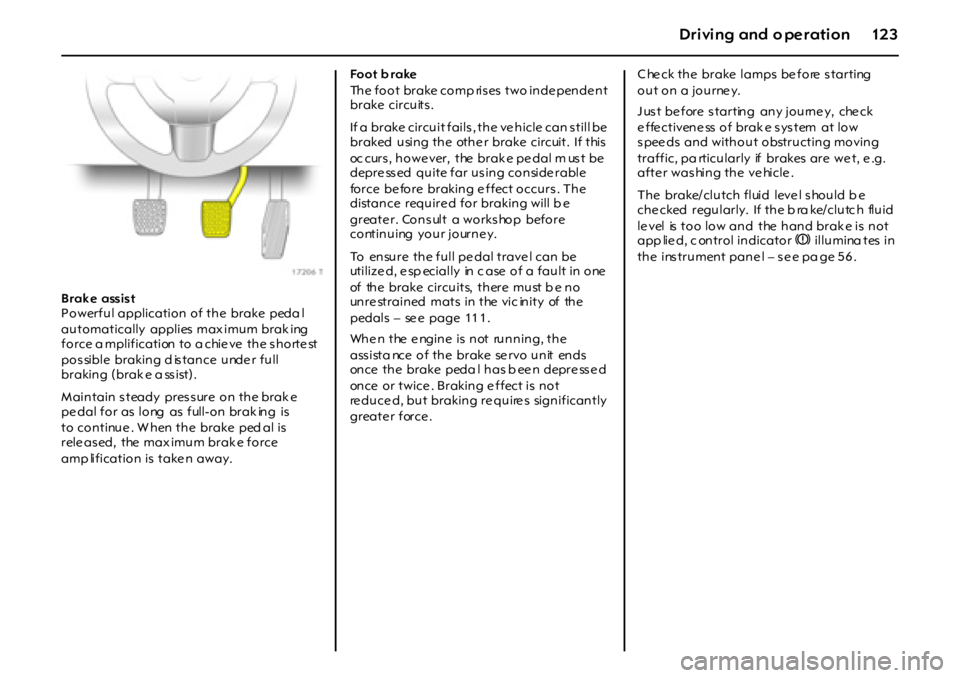
12 3Dr i vi ng and o pe r ati on
Brak e assist
Powerful application of the brake peda l
automatically applies max imum brak ing
force a mplification to a chie ve the s horte st
pos sible braking d is tance unde r full
braking (brak e a ss ist).
M a i n t a i n s t ea dy p r es s ur e o n t h e br a k e
pe dal for as long as full-on brak ing is
to continue . W hen the brake ped al is
rele as ed, the max imum brak e force
amp lification is take n away.Foot b rake
The foot brake comp rises two independent
brake circuits .
If a brake circuit fails , the ve hicle can s till be
braked using the othe r brake circuit. If this
oc curs , howe ver, the brak e pe dal m us t be
depre ss ed quite far us ing conside rable
force be fore braking e ffect occurs. The
distance require d for braking will b e
greate r. Consult a workshop before
continuing your journey.
To ensure the full pe dal trave l can be
utilize d, e sp ecially in c ase of a fault in one
of the brake circuits, there must be no
unre strained mats in the vic inity of the
pedals – se e page 11 1 .
When the engine is not running, the
a ss i st a nce o f t h e br a ke se r vo u n it en ds
once the brake peda l has b ee n depre ss e d
once or twice . Braking e ffect is not
re duce d, but braking re quire s significantly
greate r force .Check the brake lamps before starting
out on a journey.
Just before starting any journey, check
effectiveness of brak e system at low
s pee ds and without obstructing moving
traffic, pa rticularly if brakes are we t, e .g.
afte r was hing the ve hicle .
The brake/ clutch fluid leve l s hould b e
che cked regularly. If the b ra ke/clutc h fluid
level is too low and the hand brak e is not
app lie d, c ontrol indicatorR illumina tes in
the ins trument pane l – s e e pa ge 5 6 .
Page 124 of 190
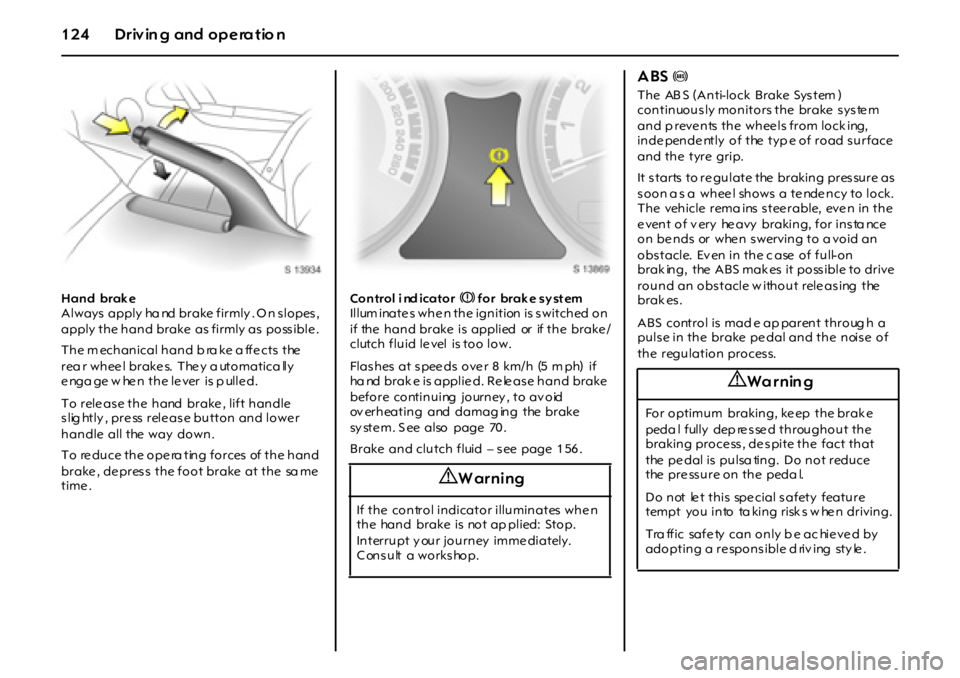
1 2 4 D r iv in g an d o p e ra t io n
Hand brak e
Always apply ha nd brake firmly . O n s lopes ,
apply the hand brake as firmly as poss ible .
The m echanical hand b ra ke a ffe cts the
rea r wheel brakes. They a utomatica lly
enga ge w hen the lever is p ulled.
To release the hand brake, lift handle
s lig htly , pre ss rele as e button and lowe r
handle all the way down.
T o re du ce t h e o p e ra t in g f o r ces of t h e h a n d
brake , de pres s the foot brake at the sa me
time .Control i nd icator R f o r b r a k e s y st em
Illum inate s whe n the ignition is s witched on
if the hand brake is applied or if the brake/
clutch fluid le vel is too low.
Flas hes at s pee ds ove r 8 km/ h (5 m ph) if
ha nd brak e is applie d. Re le as e hand brake
b ef o r e c o nt i n u i ng j o ur n ey , t o a v o id
ov erheating and damag ing the brake
sy ste m. S ee also page 70 .
Brake and clutch fluid – s ee page 1 56 .
ABS u
T h e AB S ( A n ti-lo ck Brake Sys tem )
continuously monitors the brake system
a n d p r eve n ts t h e w h ee l s f r o m l o ck i ng ,
inde pende ntly of the typ e of road surface
and the tyre grip.
It s tarts to re gulate the braking pres sure as
soon a s a wheel shows a tendency to lock.
T h e veh i cl e r em a i ns s t ee r a bl e, eve n i n t h e
e vent of v ery he avy braking, for ins ta nce
on bends or when swerving to a void an
o bs t acl e. Ev en i n t h e c ase o f f u l l- o n
brak ing, the ABS mak es it poss ible to drive
round an obs tacle w ithout rele as ing the
brak es .
ABS control is mad e ap parent throug h a
puls e in the brake pe dal and the nois e of
the regulation process.
9 Warning
If the control indicator illuminates whe n
the hand brake is not ap plied: Stop.
Interrupt y our journey immediately.
C onsult a workshop.
9 Wa r nin g
For optimum braking, ke ep the brak e
peda l fully dep re s se d throughout the
braking proce ss , de s pite the fact that
the pe dal is pulsa ting. Do not reduce
the pre ssure on the peda l.
Do not le t this spe cial safety feature
tempt you into ta king risk s w he n driving.
Tra ffic safe ty can only b e ac hie ve d by
adopting a re spons ible d riv ing sty le .
Page 144 of 190
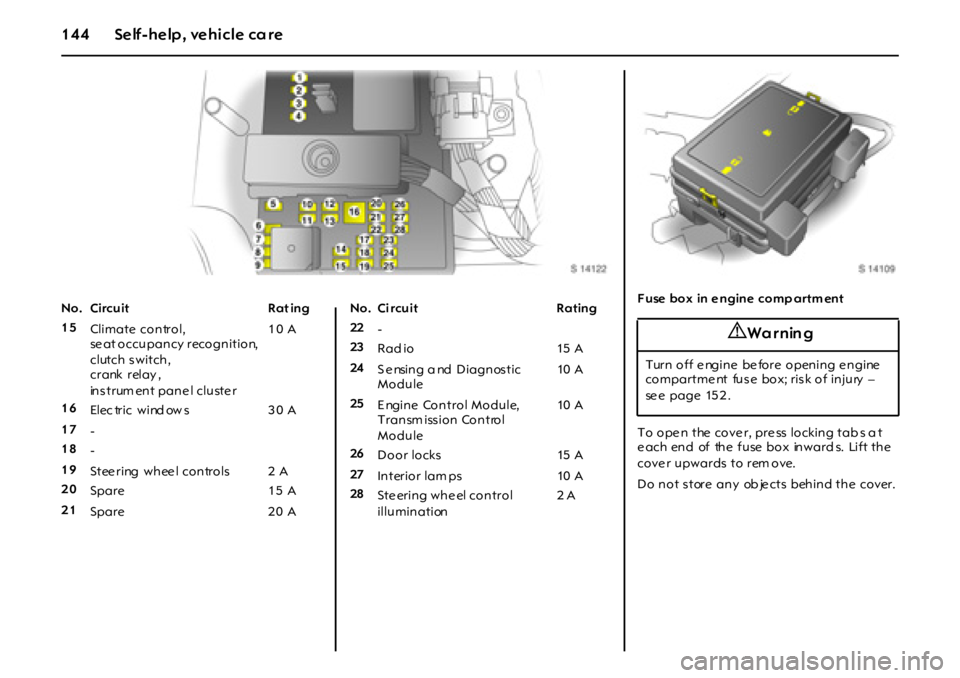
144 Self-help, vehicle care
No. Circuit Rat ing
15
Climate co n tro l,
se at occupancy recognition,
clutch s witch,
crank relay ,
instrum ent panel cluster10 A
16
El ec tr i c w i nd ow s 3 0 A
17
-
18
-
19
St ee r i ng w h ee l co n tr o l s 2 A
20
Spare 1 5 A
21
Spare 2 0 ANo. Ci rcuit Rating
22
-
23
Rad io 15 A
24
S e nsing a nd Diagnos tic
Module10 A
25
Engine Control Module,
Transm iss ion Control
Module10 A
26
Door locks 15 A
27
In terio r lam ps 10 A
28
Steering wheel control
illumination2 AF use box in e ngine comp artm ent
To open the cover, press locking tabs a t
each end of the fuse box inwards. Lift the
cove r upwards to rem ove.
Do not store any ob jects behind the cover.
9 Wa r nin g
Turn off e ngine be fore opening e ngine
compartme nt fuse box; risk of injury –
se e page 15 2 .